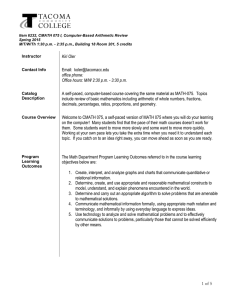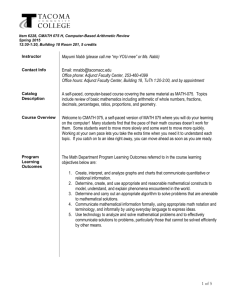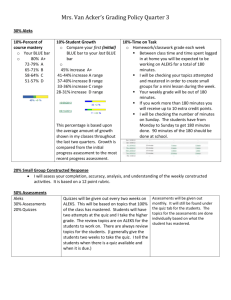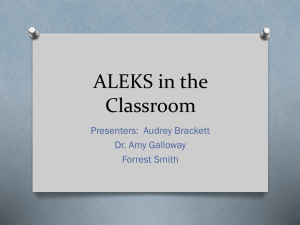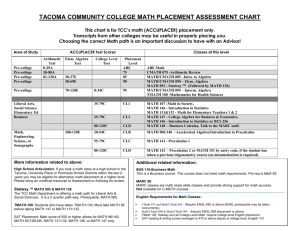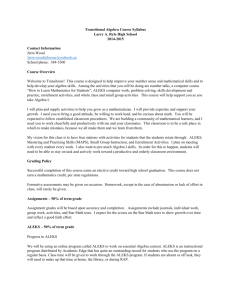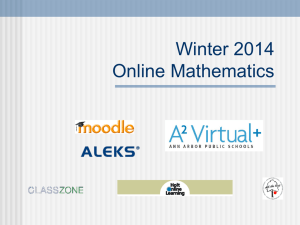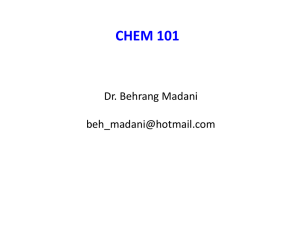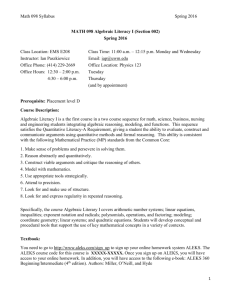wcj4m-xfcvh - Tacoma Community College
advertisement
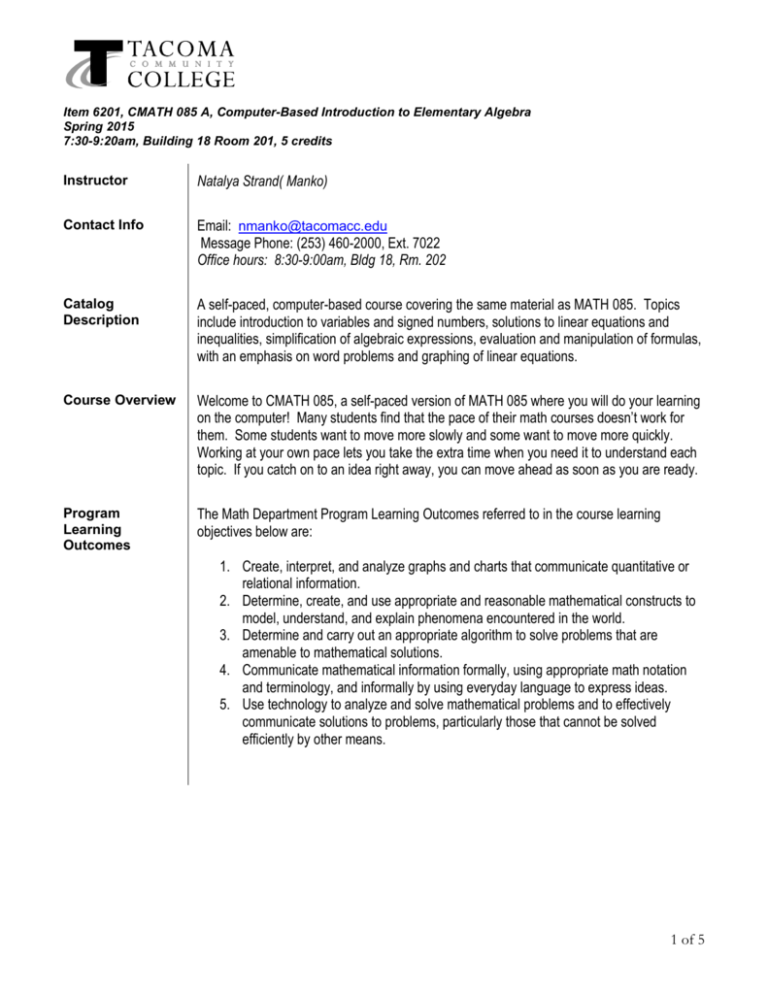
Item 6201, CMATH 085 A, Computer-Based Introduction to Elementary Algebra Spring 2015 7:30-9:20am, Building 18 Room 201, 5 credits Instructor Natalya Strand( Manko) Contact Info Email: nmanko@tacomacc.edu Message Phone: (253) 460-2000, Ext. 7022 Office hours: 8:30-9:00am, Bldg 18, Rm. 202 Catalog Description A self-paced, computer-based course covering the same material as MATH 085. Topics include introduction to variables and signed numbers, solutions to linear equations and inequalities, simplification of algebraic expressions, evaluation and manipulation of formulas, with an emphasis on word problems and graphing of linear equations. Course Overview Welcome to CMATH 085, a self-paced version of MATH 085 where you will do your learning on the computer! Many students find that the pace of their math courses doesn’t work for them. Some students want to move more slowly and some want to move more quickly. Working at your own pace lets you take the extra time when you need it to understand each topic. If you catch on to an idea right away, you can move ahead as soon as you are ready. Program Learning Outcomes The Math Department Program Learning Outcomes referred to in the course learning objectives below are: 1. Create, interpret, and analyze graphs and charts that communicate quantitative or relational information. 2. Determine, create, and use appropriate and reasonable mathematical constructs to model, understand, and explain phenomena encountered in the world. 3. Determine and carry out an appropriate algorithm to solve problems that are amenable to mathematical solutions. 4. Communicate mathematical information formally, using appropriate math notation and terminology, and informally by using everyday language to express ideas. 5. Use technology to analyze and solve mathematical problems and to effectively communicate solutions to problems, particularly those that cannot be solved efficiently by other means. 1 of 5 Course Learning Objectives Course Objectives Upon successful completion of this course, the student should be able to: (Corresponding Program Learning Outcome is listed in parentheses) 1. Interpret the concept of a variable as an unknown quantity. (2, 4) 2. Translate expressions and equations from words to algebra. (2, 4) 3. Perform operations with signed numbers. (3, 4) 4. Apply the order of operations algorithm to algebraic expressions. (3, 4) 5. Solve linear equations and inequalities using a vertical format. (3, 4) 6. Apply the commutative, associative and distributive properties. (3, 4) 7. Evaluate algebraic expressions and formulas. (3, 4) 8. Solve formulas for a specified variable. (3, 4) 9. Solve basic application problems algebraically. (2, 3, 4) 10. Represent and interpret information numerically, algebraically, and graphically. (1, 2, 3, 4) 11. Create a linear graph given an equation or data points. (1, 2, 3, 4) 12. Use a scientific calculator appropriately. (5) 13. Write clear and complete solutions to mathematical problems, including correct notation and written explanations when appropriate. (4) Instructional Methods Used This course is computer based. You will learn by reading explanations, watching videos of examples, and doing practice problems on the computer using ALEKS software (www.ALEKS.com). An instructor will always be available to answer questions during class time. Note: ALEKS does not work well in MS Explorer. Please use Firefox or Chrome as your browser. Textbooks & Supplemental Materials There is no textbook for this course. An access code for the ALEKS software is required. This may be purchased from the TCC Bookstore or online at ALEKS.com. You may purchase basic ALEKS access, or for an additional $15 (approximately) you may purchase “ALEKS 360,” which will include an interactive textbook, videos, and animations not available in the basic access. Supplies You will need headphones or earbuds to use the videos and animated examples in ALEKS in the classroom and notebooks for working problems that require paper and pencil. Calculator Policy ALEKS will provide you with a calculator only if you are working on a problem for which it is appropriate to use a calculator. You are NOT allowed to use any calculator in class or for the final exam unless ALEKS provides it. Technology Most of the instruction for this course comes from computer software, so you need to have access to a computer with high speed internet for at least two hours a day. If your computer does not have high speed internet access, computers are available on campus at the MARC (19-22), the Information Commons (Building 16), and the library (Building 7). Attendance To be successful in this course, you must work steadily. You are expected to attend class daily and work ten to fifteen hours a week on ALEKS. 2 of 5 Course Structure You begin this CMATH course by taking the ALEKS assessment for CMATH 085, which will determine what you might already know about CMath 85 and what you still need to learn. The assessment takes 45 minutes to an hour, and the results are displayed in a pie chart. If you need to leave the computer before you have finished the assessment, ALEKS will save it so you can return to it. You will learn the course material by reading explanations and examples, watching videos with more examples, and practicing on-line. Your instructor is always there during class time to help too. ALEKS will give you assessments on a regular basis to evaluate your learning. These assessments may result in losing or gaining portions of your pie. Your instructor may require you to take an assessment during class time. When you master all the material in the course, the pie chart is completely full, and you take the Goal Completion Assessment on ALEKS. All coursework and login hours, aside from the final exam, must be completed by the last regular class day of the quarter (this quarter, that date is Monday, June 8) Evaluation Criteria & Grading Standards CMATH 085 must be taken on a Satisfactory/Unsatisfactory basis. End of the Quarter Outcomes: There are three possibilities: 1. You have successfully completed the course. a. You have completed your pie, and b. you have taken the ALEKS Goal Completion Assessment, and scored 100% on it, or scored below 100% and completed the pieces that were re-entered into the pie, and c. You have passed the final exam with 70% or better. In this case, you are given a grade of “S” in MATH 085 and are dropped from CMATH 085 You may then take MATH 090 or CMATH 090. 2. You have made sufficient progress in the course but have NOT completed your pie. a. You have worked a minimum of 90 hours and have added 112 topics to your pie or b. You have worked a minimum of 120 hours and have added 78 topics to your pie. In this case, you are given a grade of “S” in CMATH 085 and may re-take CMATH 085 to finish the course, or you may take a classroom section of MATH 085. 3. You have NOT made sufficient progress, which means you have not met criteria 1 or 2 above. In this case, you are given a grade of “U” (unsatisfactory) in CMATH 085 and must register for MATH 085 retake the ACCUPLACER . You may not register for any other CMATH course. For Returning CMATH students: Students may have up to two full quarters to complete their CMATH work for a given level, as long as during their first quarter they make sufficient progress and put in the required number of hours. If this is your 2nd quarter working on the same CMATH level as a previous quarter, you must complete your pie and take your final exam by the end of the quarter. If you do not complete your pie by the end of this quarter, you will not be allowed to take the same CMATH level for a 3rd time. 3 of 5 Final Exam The final exam will be given within ALEKS. A passing score on the final is 70% or better. You may take the final a maximum of two times. If you complete the pie and the ALEKS Goal Completion Assessment before the beginning of the last week of classes, special arrangements will be made to take your final exam early. If you completer the pie and the ALEKS Goal Completion Assessment by the last class day of the quarter, your final is offered on the day indicated on the TCC Final Exam Schedule. Second attempts at the final may be made on the last day of final exams. Withdrawals & Incompletes TCC policy states that anyone can withdraw from a class on or before May 22, IF the student fills out the necessary add/drop form and turns it in to registration. After that, you need the instructor’s permission. THAT MEANS: you need to tell me your reasons for wanting to withdraw (warning: “I’ve run out of time,” is not reason enough to get a withdrawal after Friday , May 22. In general, if you have been making satisfactory progress at the time of your request, a WI grade will be given. If not, a U grade will be given (exceptions may be made, depending on the circumstances). Students who simply stop coming to class will receive a U. Because of the structure of CMath, Incomplete (I) grades will generally not be given. Academic Dishonesty The TCC Academic Dishonesty policy states: Students are expected to be honest and forthright in their academic endeavors. Cheating, plagiarism, fabrication or other forms of academic dishonesty corrupt the learning process and threaten the educational environment for all students. In this course, sanctions for academic dishonesty will be as follows: If the first instance is before the final exam, the student will be given a warning. The second instance will result in the student being given a grade of “U” in CMATH 085. The student must then register for MATH 085 or retake the ACCUPLACER . The student may not register for another CMATH course. Any academic dishonesty on the final exam will result in the student being given a grade of “U” in CMATH 085. The student must then register for MATH 085 or retake the ACCUPLACER . The student may not register for another CMATH course. Accommodations Students with Special Needs: All students are responsible for all requirements of the class, but the way they meet these requirements may vary. If you need specific auxiliary aids or services due to a disability, please contact the Access Services office in Building 7 (253-5665328). They will require you to present formal, written documentation of your disability from an appropriate professional. When this step has been completed, arrangements will be made for you to receive reasonable auxiliary aids or services. The disability accommodation documentation prepared by Access Services must be given to me before the accommodation is needed so that appropriate arrangements can be made. 4 of 5 Classroom Policies Please be sure that cell phone/beepers are on vibrate. If you need to take a call, please take it out in the hallway. Because we are in a computer classroom, food and beverages are not allowed in class. Since we are a very diverse group, please be respectful of each other. Help each other when you can, but keep non-productive talk to a minimum. Dispute Resolution If you have questions or complaints about your grade or any other aspect of the class, please follow the steps below: 1. See the instructor and present your case in a professional, unemotional manner. Instructors are always willing to listen to a good argument and respond considerately. If you are not satisfied, go to step 2. 2. See the Mathematics Department Chair, Carol Avery, in Building F2, Room 7. If you are still not satisfied, go to step 3. 3. See the Dean of the Math, Science, and Engineering Division, Mike Flodin, in Building 15. Resources for Tutoring The Al-Kwarizmi Math Advising and Resource Center (The MARC): The MARC is located in 19-22, and has a computer lab where you can access ALEKS. The MARC has math tutors and math instructors available to answer questions. For best results, bring specific questions or problems you are working on to ask about. Even if you do not have any problems, the Math Center is a pleasant place to study. You are always welcome there! The Writing and Tutoring Center: The Tutoring Center is located in building 7, room 221. Student tutors are available by appointment for one-on-one tutoring. The hours during which tutoring is available in specific subjects may vary from quarter to quarter. Call the Tutoring Center at (253) 566-6032 to find out what their current schedule is. Drop-in tutoring is available on Friday afternoons. 5 of 5

